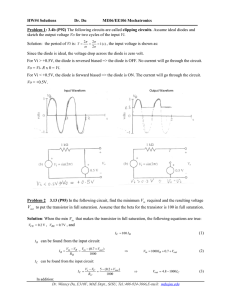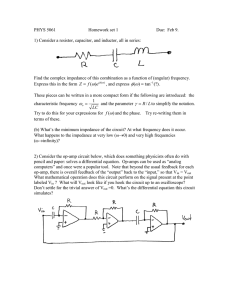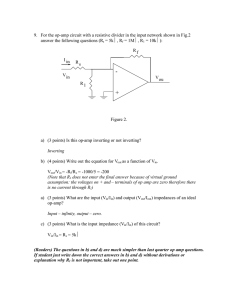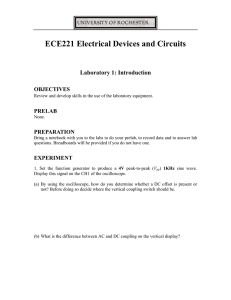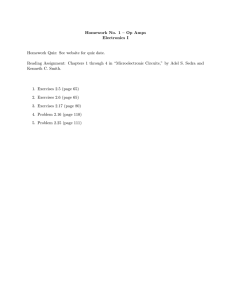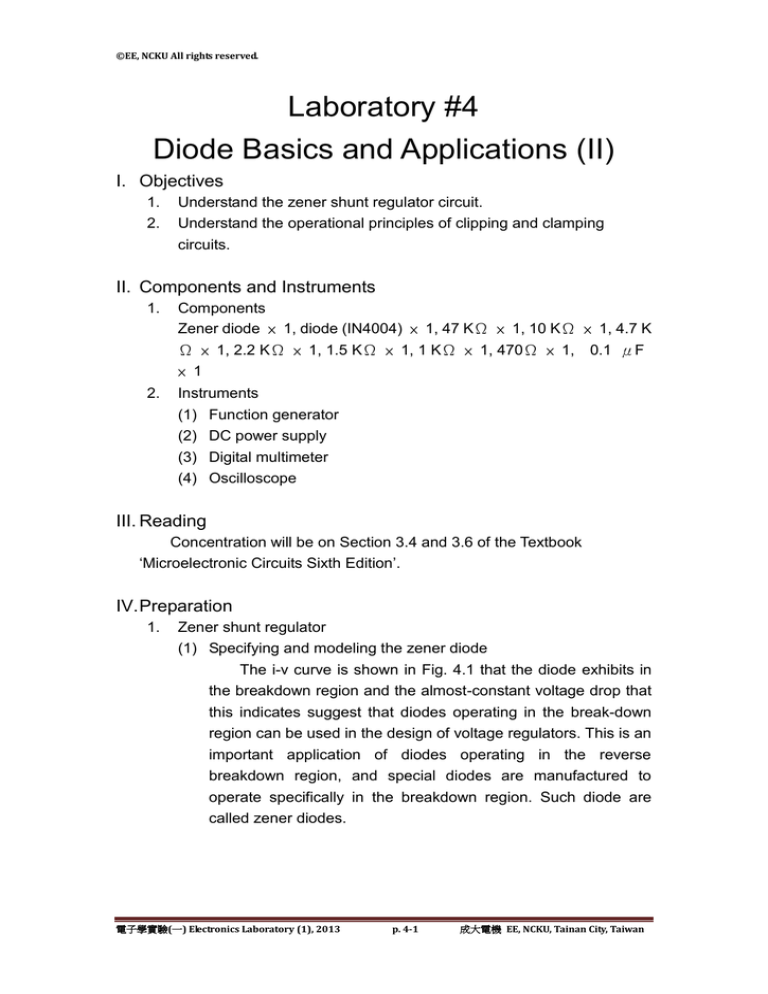
© EE, NCKU All rights reserved.
Laboratory #4
Diode Basics and Applications (II)
I. Objectives
1.
2.
Understand the zener shunt regulator circuit.
Understand the operational principles of clipping and clamping
circuits.
II. Components and Instruments
1.
Components
Zener diode × 1, diode (IN4004) × 1, 47 KΩ × 1, 10 KΩ × 1, 4.7 K
Ω × 1, 2.2 KΩ × 1, 1.5 KΩ × 1, 1 KΩ × 1, 470Ω × 1, 0.1 μF
× 1
2.
Instruments
(1) Function generator
(2) DC power supply
(3) Digital multimeter
(4) Oscilloscope
III. Reading
Concentration will be on Section 3.4 and 3.6 of the Textbook
‘Microelectronic Circuits Sixth Edition’.
IV. Preparation
1.
Zener shunt regulator
(1) Specifying and modeling the zener diode
The i-v curve is shown in Fig. 4.1 that the diode exhibits in
the breakdown region and the almost-constant voltage drop that
this indicates suggest that diodes operating in the break-down
region can be used in the design of voltage regulators. This is an
important application of diodes operating in the reverse
breakdown region, and special diodes are manufactured to
operate specifically in the breakdown region. Such diode are
called zener diodes.
電子學實驗(一) Electronics Laboratory (1), 2013
p. 4-1
成大電機 EE, NCKU, Tainan City, Taiwan
© EE, NCKU All rights reserved.
Fig. 4.1 A diode i-v characteristics
The almost-linear i-v characteristic of the zener diode
suggests that the device can be modeled as indicated in Fig. 4.2.
Fig. 4.2 Model for the zener diode
(2) Zener shunt regulator circuit
The zener shunt circuit is shown in Fig. 4.3, the use of zener
diodes in the design of shunt regulators, so named because the
regulator circuit appears in parallel (shunt) with load.
RS
+
Vin
ZD
RL
Vout
-
Fig. 4.3 Zener shunt regulator circuit
電子學實驗(一) Electronics Laboratory (1), 2013
p. 4-2
成大電機 EE, NCKU, Tainan City, Taiwan
© EE, NCKU All rights reserved.
There are two parameters to evaluate the regulation function:
line regulation and load regulation.
In Fig. 4.3, we can use the model in Fig. 4.2 to derive the
equation (1) as following:
Vout VZ 0
R r
RS
rZ
Vin
I L S Z
RS rZ
RS rZ
RS rZ
…(1)
The line regulation is defined as equation (2):
Vout
rZ
Line regulation
…(2)
Vin
RS rZ
Line regulation is a measure of the ability of the power
supply to maintain its output voltage given changes in the input
line voltage. Line regulation is expressed as percent of change in
the output voltage relative to the change in the input line voltage.
The load regulation is defined as equation (3):
Load regulation
R r
Vout
S Z
I L
RS rZ
…(3)
Load regulation is a measure of the ability of an output
channel to remain constant given changes in the load.
2.
Clipping circuits
Clipping circuits are also called clipper or limiters. Limiters find
application in a variety of signal –processing systems. One of their
applications is in limiting the voltage between the two input terminals
of an opamp to a value lower than the breakdown voltage of the
transistors that make up the input stage of the opamp circuit.
Diodes can be combined with resistors to provide simple
realizations of the limiter function. A number of examples are depicted
in Fig. 4.4 to Fig. 4.9. In each part of the figure both the circuit and its
transfer characteristics are given. And in these examples, we assume
that the diodes are ideal for simplification.
電子學實驗(一) Electronics Laboratory (1), 2013
p. 4-3
成大電機 EE, NCKU, Tainan City, Taiwan
© EE, NCKU All rights reserved.
Vin
+5 V
0
-5 V
D
RL
Vin
Vout
+5 V
Vout
0
-5 V
Fig. 4.4 The output having series connection of diode – 1
Vin
+5 V
0
D
-5 V
RL
Vin
+
Vout
2V
+5 V
Vout
+2 V
0
-
-5 V
Fig. 4.5 The output having series connection of diode – 2
Vin
+5 V
0
D
-5 V
RL
Vin
-
Vout
2V
+
+5 V
Vout
0
-2 V
-5 V
Fig. 4.6 The output having series connection of diode – 3
電子學實驗(一) Electronics Laboratory (1), 2013
p. 4-4
成大電機 EE, NCKU, Tainan City, Taiwan
© EE, NCKU All rights reserved.
Vin
+5 V
0
RS
-5 V
RL
D
Vin
+5 V
Vout
Vout
0
-5 V
Fig. 4.7 The output having parallel connection of diode – 1 (RS << RL)
Vin
+5 V
0
RS
-5 V
D
Vin
+
RL
+5 V
Vout
2V
Vout
+2 V
0
-
-5 V
Fig. 4.8 The output having parallel connection of diode – 2 (RS << RL)
Vin
+5 V
0
RS
-5 V
D
Vin
-
RL
+5 V
Vout
Vout
2V
+
0
-2 V
-5 V
Fig. 4.9 The output having parallel connection of diode – 3 (RS << RL)
電子學實驗(一) Electronics Laboratory (1), 2013
p. 4-5
成大電機 EE, NCKU, Tainan City, Taiwan
© EE, NCKU All rights reserved.
3.
Clamping circuits
Clamping circuits are used to shift signal dc level without
changing the shape of waveform. The circuits are also called dc
restorers. A number of examples are depicted in Fig. 4.10 to Fig. 4.12.
In each part of the figure both the circuit and its transfer
characteristics are given.
Vin
+5 V
C
0
-5 V
D
Vin
Vout
+10 V
Vout
+5 V
0V
Fig. 4.10 The clamping circuit – 1
Vin
+5 V
C
0
-5 V
D
Vin
+
Vout
2V
+2 V
Vout
0
-8 V
Fig. 4.11 The clamping circuit – 2
Vin
+5 V
0
C
-5 V
D
Vin
+
Vout
+12 V
Vout
2V
+2 V
0
Fig. 4.12 The clamping circuit – 3
電子學實驗(一) Electronics Laboratory (1), 2013
p. 4-6
成大電機 EE, NCKU, Tainan City, Taiwan
© EE, NCKU All rights reserved.
V. Explorations
1.
Zener shunt regulator circuit
Connect the circuit as shown in Fig. 4.13 and use your DMM to
measure the dc voltage of Vout, and the current (IZ) through the zener
diode. Please finish the Table 4.1 and Table 4.2.
RS
1.5k Ω
+
Vin
IZ
IL
RL
ZD
Vout
6.2V
-
Fig. 4.13
Table 4.1 (RL = 10 KΩ)
Vin (V)
0
3
6
9
12
1k
470
Vout (V)
IZ (mA)
Table 4.2 (Vin = 12 V)
RL (Ω)
10 k
4.7 k
2.2 k
Vout (V)
IL (mA)
2.
Clipping circuits
Connect the circuit as shown in Fig. 4.4 to Fig. 4.9, and use the
oscilloscope to measure the waveforms of Vout. The input voltage (Vin)
is a 10Vpp and 1kHz sine wave, and the value of RS is 470 Ω and RL
is 47 kΩ. The diode can be the 1N400X series.
3.
Clamping circuits [Bonus]
Connect the circuit as shown in Fig. 4.10 to Fig. 4.12, and use
the oscilloscope to measure the waveforms of Vout. The input voltage
(Vin) is a 10Vpp and 1kHz square wave, and the value of C is 0.1μF.
The diode can be the 1N400X series.
電子學實驗(一) Electronics Laboratory (1), 2013
p. 4-7
成大電機 EE, NCKU, Tainan City, Taiwan
© EE, NCKU All rights reserved.
Laboratory #4 Pre-lab
Class:
Name:
Student ID:
Note: In these simulations, the diode can be the 1N400X series.
1.
Connect the circuit as shown in Fig. 4.13 and simulate the circuits by
PSpice. Show the output (Vout) waveform which is across the load
resistor. Set the Vin to 12 V, and set the value of RL to10 kΩ. And
select the zener diode (D1n750). Please attach the schematic and
simulation results.
2.
Connect the circuit as shown in Fig. 4.4 to Fig. 4.9 and simulate the
circuits by PSpice. The input voltage (Vin) is a 10Vpp and 1kHz sine
wave, and the value of RS is 470 Ω and RL is 47 kΩ. Show the output
(Vout) waveform. Please attach the schematic and simulation results.
3.
Connect the circuit as shown in Fig. 4.10 and Fig. 4.12 and simulate
the circuits by PSpice. The input voltage (Vin) is a 10Vpp and 1kHz
square wave, and the value of C is 0.1μF. Show the output (Vout)
waveform.
Please attach the schematic and simulation results.
電子學實驗(一) Electronics Laboratory (1), 2013
p. 4-8
成大電機 EE, NCKU, Tainan City, Taiwan
© EE, NCKU All rights reserved.
Laboratory #4 Report
Class:
Name:
Student ID:
Exploration 1
Table 4.1
Vin (V)
0
3
6
9
12
2.2 k
1k
470
Vout (V)
IZ (mA)
Table 4.2
RL (Ω)
10 k
4.7 k
Vout (V)
IL (mA)
Exploration 2
Output waveforms:
Exploration 3 [Bonus]
Output waveforms:
Problem 1
Please derive the equation (1) from Fig 4.3.
Vout VZ 0
R r
RS
rZ
Vin
I L S Z
RS rZ
RS rZ
RS rZ
…(1)
Problem 2
What is the regulation function which we test in the Table 4.2?
(line regulation or load regulation) And please make a short
description of it.
Problem 3
Observe the experiment results from Fig. 4.7 to Fig. 4.9, and
what is the limitation of the clipping circuits? (Hint: the relation of RL
and RS)
電子學實驗(一) Electronics Laboratory (1), 2013
p. 4-9
成大電機 EE, NCKU, Tainan City, Taiwan
© EE, NCKU All rights reserved.
Problem 4
Given 47 kΩ resistor and a sine wave input with 10Vpp amplitude
and 1 kHz frequency. Please design a clipper to generate the output
waveform shown in Fig. 4.14.
Vin
+5 V
0
-5 V
+5 V
Vout
+2 V
0
-2 V
-5 V
Fig. 4.14
Conclusion
電子學實驗(一) Electronics Laboratory (1), 2013
p. 4-10
成大電機 EE, NCKU, Tainan City, Taiwan


